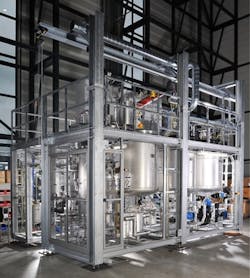Chemical Makers Roll Out More Bio-Based Feedstocks
Spurred largely by two main drivers — customer demand and regulatory developments, and the prospect of developing products with new properties and producing molecules more efficiently — chemical makers are increasingly using renewable raw materials.
This certainly holds true at BASF, Ludwigshafen, Germany. One of its earliest offerings on a commercial scale was 1,4-butanediol (BDO), which uses cellulosic sugars as a renewable feedstock and technology licensed from Genomatica, San Diego, Calif.
BDO and its derivatives have many uses, such as making plastics for the automotive and textile industries. BASF’s main focus today is on producing bio-based polytetrahydrofuran 1000 (PolyTHF 1000).
[callToAction ]
With good dynamic mechanical properties, even in variable temperatures, PolyTHF 1000 primarily serves as a chemical component in thermoplastic polyurethane, itself an ingredient used in the manufacture of skis and roller skates, shoe soles, dashboard films in the automotive industry, and many other products.
“Various customers are carrying out ongoing testing of renewable PolyTHF 1000 in other, different applications. With the introduction of new products using it, we plan additional PolyTHF 1000 campaigns — including with different grades — in existing manufacturing plants in 2017,” notes Tobias Berg, global communications, intermediates division.
All of BASF’s renewable resources work is governed by the mass balance method it developed jointly with global technical service organization TÜV SÜD, Munich, Germany. That method mathematically allocates any amount of bio-based raw material used as a feedstock to the respective end products on the basis of their formulation — using the TÜV SÜD certified method.
So far, TÜV SÜD has issued certificates for a broad range of BASF products, including superabsorbent polymers in baby diapers, engineering plastics and various dispersions.
Biorefinery Progress
Meanwhile, one of BASF’s earlier interests, the Plantrose two-stage supercritical hydrolysis-based process for cellulosic sugars developed by Renmatix, Pa., has just attracted further funding. BASF staked $30 million in a non-exclusive pilot venture in early 2012. In September 2016, a group led by Bill Gates and Total, Paris, poured in $14 million. The new money will help Renmatix licensees build Plantrose-enabled biorefineries in countries such as Canada, India, Malaysia and the U.S.
Total made an initial investment in the technology in 2015; the new deal includes a license to operate one million m.t./y of cellulosic sugar capacity. The company has a target of using low-carbon processes to account for 20% of its business portfolio by 2036.
Renmatix CEO Mike Hamilton hails the new investment — particularly Total’s million-m.t. license — as compelling indicators of Plantrose technology’s maturation toward the biorefinery scale.
Renmatix also is building on its industrial sugars’ experience by expanding its product portfolio to include crystalline cellulose and proprietary Omno lignin-based polymers that can be tailored to meet customer needs with tunable characteristics such as molecular weight and particle size.
Italian Initiative
Also in September, Genomatica’s BDO technology received a major boost with the opening of a €100-million ($112-million) Mater-Biotech plant in Bottrighe, Italy, by Novamont, Novara, Italy.
Higher-than-anticipated demand for products manufactured from renewable materials spurred the Italian company to boost capacity from the original plan of 18,000 m.t./y; the plant will produce more than 30,000 m.t./y when it reaches full output in early 2017. Novamont claims the facility is the world’s first commercial-scale facility for the bio-based production of a major chemical intermediate.
Genomatica says its BDO process resembles the conventional one but delivers better economics and sustainability. During the development process with Novamont, Genomatica used what it describes as “commercial scale first” thinking to make certain the process would operate reliably at full scale. The two companies also worked very closely during plant design and construction technology transfer and plant startup to ensure a smooth and positive outcome.
Figure 1. Hydrotreatment process at Porvoo site can produce diesel fuels from a variety of natural oils, including ones in industrial wastes. Source: Neste.
BDO produced by the plant enables Novamont to deliver its fourth-generation of Mater-Bi bioplastics with greater sustainability. Mater-Bi is used for biodegradable, compostable products such as fruit and vegetables bags, mulch film and coffee capsules. Products made with this new BDO will save an estimated 56% of greenhouse gas emissions compared to the use of conventional BDO.
In addition, the plant is a starting point for further integration with both feedstock supplies and product manufacturing in the region. Novamont hopes eventually to have six interconnected sites and four new proprietary biorefining technologies there.
In a separate but related development, Genomatica has forged an alliance with Ginkgo Bioworks, Boston, Mass., to accelerate commercialization of more-sustainable high-value intermediate and specialty chemicals. The aim is to allow mainstream chemical producers to explore and adopt new biological technologies.
“Genomatica and Ginkgo now make it practical and feasible for existing and new industry participants to access, license and deploy cost-effective and innovative biotechnology,” says Carlos A Cabrera, executive chairman, Genomatica — pointing to the success of Novamont’s BDO plant as proof that new processes can be developed and implemented to work at high-volume commercial plants.
Moving Beyond Fuels
Meanwhile, Neste, Espoo, Finland, is further developing its proprietary NEX biomass-to-liquid (NEXBTL) process. This technology stemmed from the company’s research-and-development efforts to find a hydrotreatment method for converting natural oils such as vegetable oil and a range of industrial waste and residues into renewable diesel fuels.
Since the first patent was applied for in 1996, four commercial plants have gone into operation: two at Porvoo, Finland, in 2007 (Figure 1); one in Singapore in 2010; and, most recently, in Rotterdam, The Netherlands, in 2011. Their current capacity totals over two million m.t./y of renewable diesel.
“It took some years to increase to large-scale production but, at the same time, the market developed as the demand for more-responsible renewable fuels grew remarkably,” notes Petri Lehmus, vice president, R&D.
This still-growing market spurred the company to allocate 70% of its 2015 R&D spending — €41 million ($46 million) — to developing future raw materials, plus research on NEXBTL technology and new renewable products.
One of the results of these efforts is a change in emphasis away from solely producing biofuels.
“The technology offers interesting opportunities outside the traffic fuel segment. Neste renewable diesel can replace fossil raw materials in chemical industry applications, for instance, in the production of renewable solvents and renewable plastics. Renewable solvents have excellent properties and are a more environmentally friendly option for use in the production of paints, glues, detergents and cosmetics,” comments Lehmus.
Avantherm, Stockholm, a maker of heat transfer fluids, certainly agrees. In April 2016, the Swedish firm revealed that renewable isoalkane produced from Neste’s NEXBTL process will serve in a range of its products, starting initially with a coolant to replace glycol. Transformer oils and release fluids should launch shortly, with other products promised throughout 2017.
Neste has hailed this development as an important milestone in its strategic goal to develop business beyond transportation fuels. The company now sells its renewable isoalkane to customers directly and to two partners that further process and market products derived from it. One, Haltermann Carless, Hamburg, Germany, focuses on refining and blending specialty products. The other, Total Fluides, Paris, is using it to help meet the company’s low-carbon-emissions production target.
In September, Neste announced it had joined forces with furniture maker IKEA, Almhult, Sweden, in an initiative to spur the use of renewable bio-based materials in polymer production. IKEA’s stated intent is to reduce its dependence on virgin fossil-based materials and open an important pathway to industrializing production of plastics from more-sustainable feedstock.
The companies have invited others to join the initiative; their target is to produce the first proof-of-concept during 2017. They also expect to widen their cooperation to include emerging novel process technologies.
Meanwhile, Neste is conducting further research to broaden both its renewable raw material base and NEXBTL technology. Lehmus foresees
new products, including distillates and bioplastics being manufactured from raw materials such as algae oil and agriculture and forest residues.
“Laboratory-scale batches of Neste renewable diesel have already been produced from these feeds,” he adds.
Figure 2. Unit in Geleen, The Netherlands, catalytically converts bio-based carbohydrates into furandicarboxylic acid. Source: Avantium.
Plastic Partnership
Also new is the announcement by Avantium, Amsterdam, and Toyobo, Osaka, Japan, of a partnership to further develop polyethylene furandicarboxylate (PEF) polymerization and PEF films.
PEF is a 100% bio-based plastic jointly developed by the two companies on Avantium’s proprietary YXY technology, which produces furandicarboxylic acid (FDCA) by the catalytic conversion of bio-based carbohydrates (Figure 2).
PEF films are aimed at applications in food packaging, electronic displays and medical devices. Such films boast a ten-times higher oxygen barrier, a two-to-three-times higher water-vapor barrier and better mechanical strength than standard polyethylene terephthalate ones.
Originally a textile company, Toyobo now focuses on developing polymerization processes to manufacture high-performance products and is collaborating with Mitsui & Co., Tokyo, on market development for the PEF films. The two have been partnering since December 2015; the first of the new films should come off the production lines in 2017.
Avantium also is in negotiations with BASF about establishing a joint venture for the production and market development of FDCA and the marketing of PEF.
Coatings Collaboration
Meanwhile, Solvay, Brussels, is in a three-year agreement with AkzoNobel, Rotterdam, aimed at increasing the use of renewable raw materials in the Dutch firm’s paints and coatings; this pact builds on an existing partnership between the two companies.
Under the terms of the deal, AkzoNobel progressively will increase the use of Solvay’s bio-based epichlorohydrin, or Epicerol, which many of the company’s resins for its coatings products already contain. AkzoNobel’s target is to source 20% of its epichlorohydrin from renewable sources by the end of the 2017.
“This agreement illustrates the necessity of a lifecycle approach to sustainability, where all levels of the supply chain team up. This is the best way to minimize our global footprint and meet the environmental challenges our industry has to cope with,” notes Jean-Luc Préat, head of the Epicerol business in the Solvay emerging biochemicals global business unit. New to this type of agreement, he adds, is the partnership model between two chemical groups on the one hand, and their suppliers and customers on the other.
Improved sustainability of paints also is a focus for DSM, Heerlen, The Netherlands, which in September was named the worldwide leader in the materials industry group in the Dow Jones sustainability world index; this is the seventh time in 13 years the company has held the number one position.
One major DSM initiative is its Decovery bio-based paint resins. Binders, which are common to all paint formulations today, often contain synthetic petroleum-based resins. Decovery resins instead use renewable plant-based materials as their building blocks. Through a novel method for converting renewable materials into a durable polymer (process details are scarce), Decovery also is free of volatile organic compounds, which improves both the manufacturing environment and the experience of end-users, says the company.





